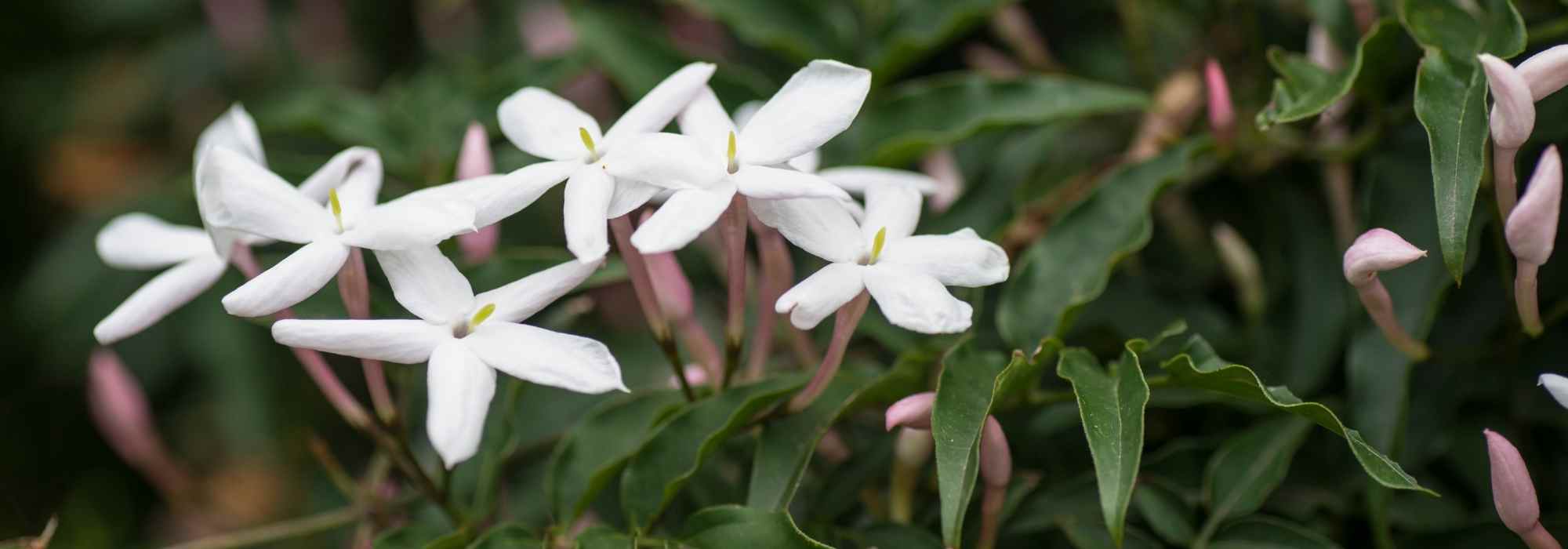
Choosing a Jasmine
From winter jasmine to star jasmine: our buying guide to make the right choice
Contents
Jasmine is one of the most fragrant plants in the plant kingdom, used in perfumery and in our gardens for olfactory pleasure, but also visual delight, as this climbing plant is so refined. For travellers, jasmine irresistibly evokes distant and eastern lands.
Revealing a charming star-shaped tubular flowering, most often white, but also yellow or pink, jasmine is ornamental in the depths of winter or in the height of summer, depending on the varieties. Jasmine belongs to the olive family and includes a multitude of attractive cultivars. However, many species fall under the name jasmine, so that between a Jasmin nudiflorum, a white jasmine, a Trachelospermum jasminoides, or a St. Stephen’s jasmine, one can sometimes be quite confused about which jasmine to choose!
So, how do you choose a jasmine? By its fragrance or the colour of its flowering, the persistence of its foliage, or its hardiness? We assist you with some tips in this buying guide to find the jasmine that will perfume your terrace or garden.
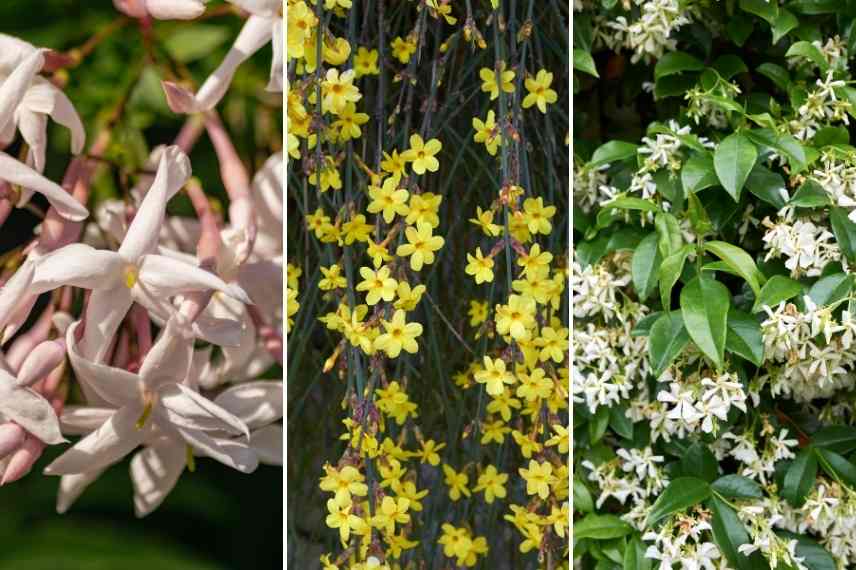
There are many jasmines: here from left to right, White jasmine, Winter jasmine, and Star jasmine
Which jasmine are we talking about?
Jasmine is a vast genus comprising around 300 species… one could easily get lost when it comes to making a choice. Especially since, just to mention the famous white jasmine, there are two quite different plants. In our latitudes, we find evergreen, semi-evergreen, and deciduous species. Depending on the family to which the jasmine belongs, it becomes easier to navigate:
- Among the Oleaceae: Jasminum humile, Jasminum polyanthum (white jasmine or winter jasmine), Jasminum nudiflorum (or winter jasmine), Jasminum officinale (or white jasmine, common jasmine), Jasminum x stephanense also known as pink jasmine, Jasminum grandiflorum (or Spanish jasmine), Jasminum azoricum…
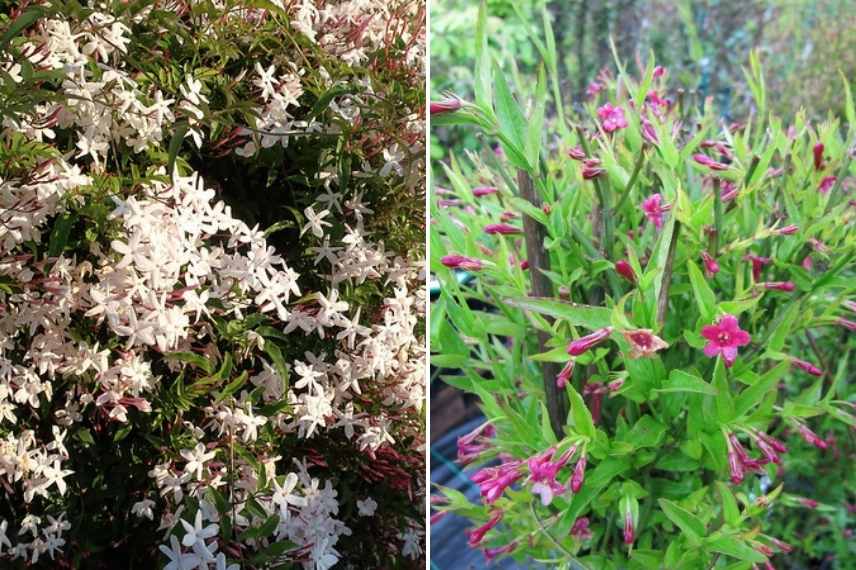
Jasminum polyanthum (© Cultivar 413) and Jasminum x stephanense (© Leonora Enking)
- Among the Apocynaceae (the family of Oleander and Periwinkles), we find the “false jasmines” including the famous Trachelosperum jasminoides with its helical flowers (also known as Rhyncospermum jasminoides), as well as the Chilean Jasmine (Mandevilla laxa) also encountered under the name Brazilian Jasmine or Dipladenia.
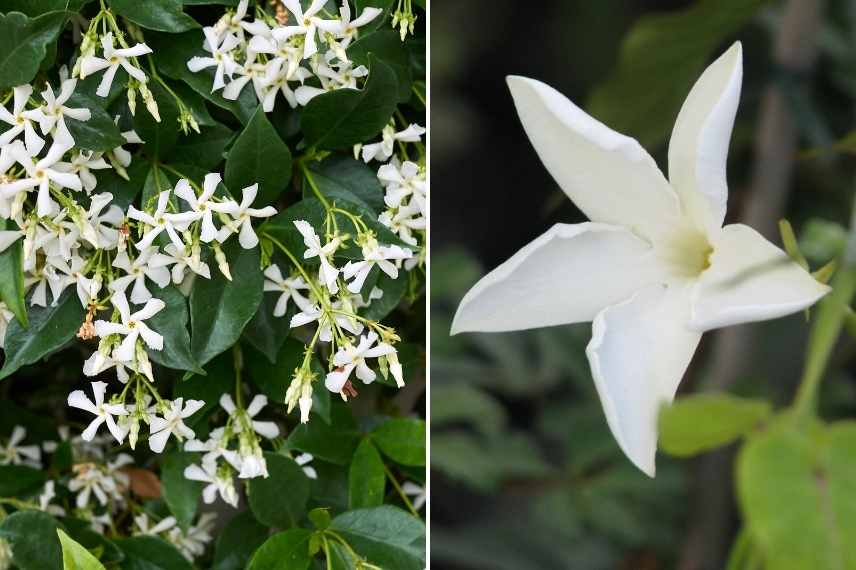
Trachelospermum jasminoides with its countless helical flowers, and Mandevilla laxa with much larger flowers
Be careful, white jasmine is subject to confusion: it can refer to Jasminum officinale also known as common jasmine, but it can also refer to Jasminum polyanthum, also called winter jasmine. It’s not straightforward, especially when we know that the winter jasmine most often referred to is the yellow-flowered jasmine known as Jasminum nudiflorum… Once again, the Latin names provide the best information!
For use in perfumery, it is Jasminum grandiflorum (or jasmine of perfumers) and Jasminum sambac (or Arabian jasmine) that are used, the latter also being used in the composition of jasmine tea.
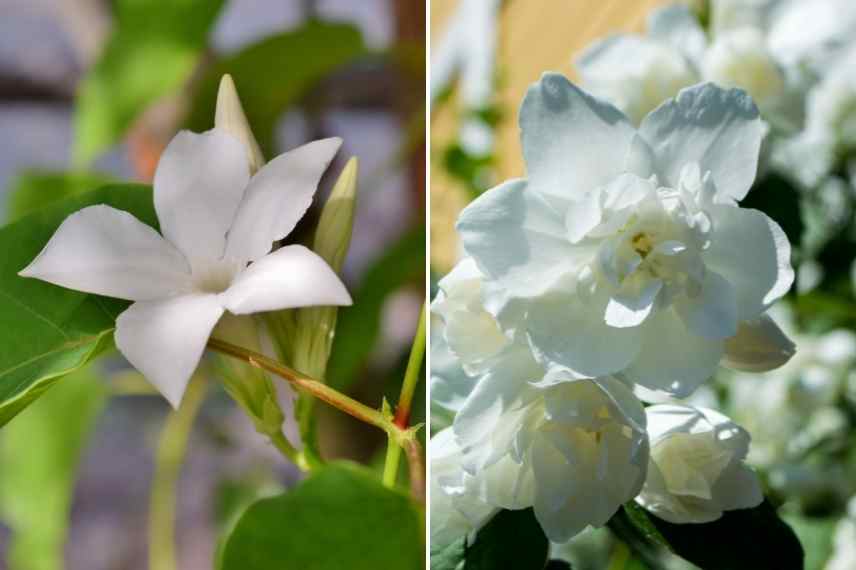
The perfumer’s jasmines: Jasmnium grandiflorum and Jasminum sambac
Moreover, many plants bear the name jasmine in their common vernacular. They belong to other botanical families: among them, the famous Virginia Jasmine, which is none other than the Trumpet Vine (or Campsis radicans in Latin), but also the Cape Jasmine (or Gardenia augusta, with much larger white flowers), Mexican Jasmine, Night Jasmine or Cestrum nocturnum and Day Jasmine (Cestrum diurnum), both belonging to the Solanaceae, the Madagascar Jasmine (Stephanotis), and Carolina Jasmine (Gelsemium sempervirens)…
Read also
Jasmin : planting, pruning and careAccording to its flowering period
Jasmines are generally divided into two categories: those that flower in winter and those that bloom in the warmer months. This is certainly one of the first criteria that will lead you to choose one variety of jasmine over another.
- Winter jasmines: the first to bloom with a shower of small yellow flowers is the winter jasmine or Jasminum nudiflorum, which brightens up dreary days with its remarkable golden flowering from December until early spring. The Primrose Jasmine (Jasminum primulinum), native to China, flowers from late winter, from March to May, also showcasing very beautiful semi-double bright yellow flowers. It is distinguished from winter jasmine by its evergreen foliage and larger flowers for a jasmine, but is much less hardy.
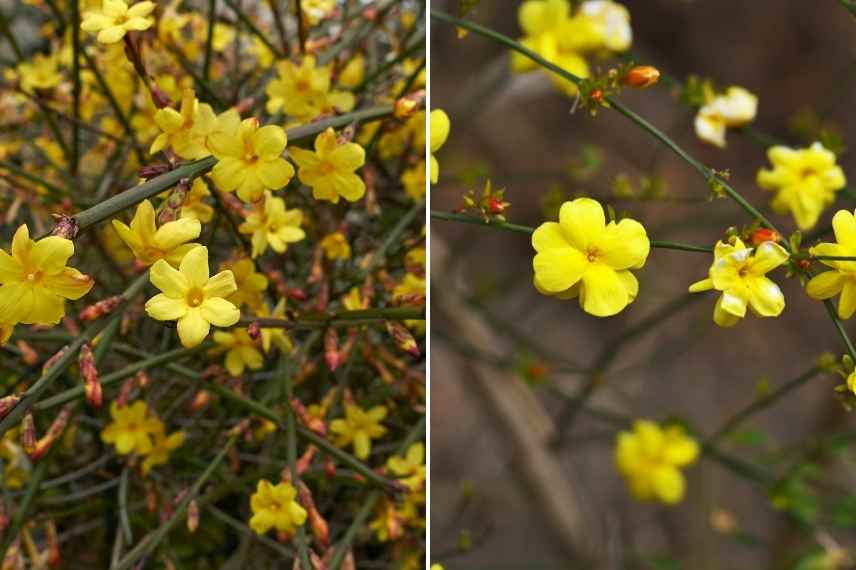
Jasminum nudiflorum or Winter Jasmine, and Jasminum primulinum or Jasminum mesneyi
- Summer jasmines: these are mainly star jasmines or Trachelospermums, which will bloom successively from May for the earliest, until August, even September. In the heart of summer, you can also find the stunning pink flowering of Jasminum x stephanense and the white flowering of Jasminum grandiflorum and Azores Jasmine. The perfumer’s jasmine (Jasminum sambac) produces flowers in mild climates until October.
Bridging the gap, some jasmines flower in spring, such as Jasminum polyanthum, from March to May, boasting an abundant porcelain pink flowering, or Jasminum multipartitum starting in May.
Some jasmines are remarkable for their long flowering: several weeks without interruption for Jasminum nudiflorum in winter and Jasminum officinale in summer, with others being very floriferous like Jasminum officinale ‘Clotted Cream’.
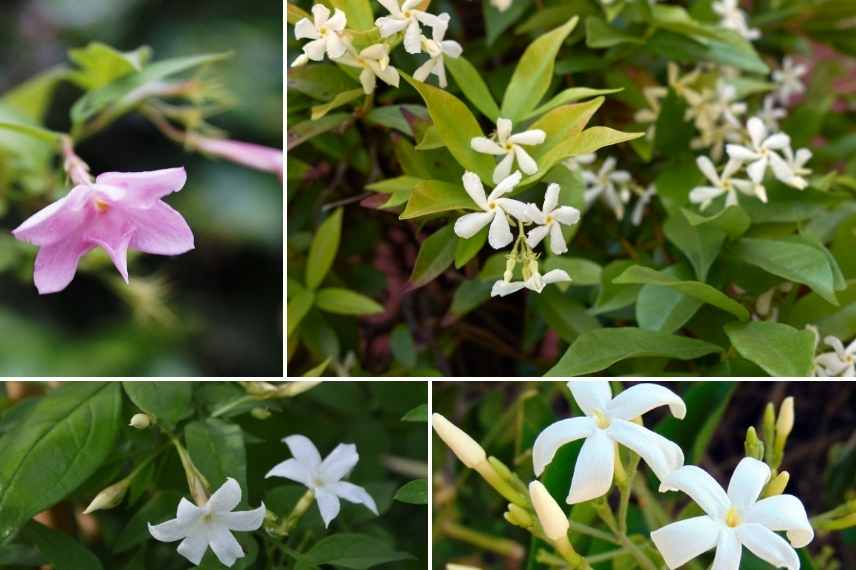 Summer is the flowering season for many varieties: the pink Jasminum x stephanense, the prolific star jasmines (or Trachelospermums jasminoides), Common Jasmine (Jasminum officinale) and Azores Jasmine (Jasminum azoricum)…
Summer is the flowering season for many varieties: the pink Jasminum x stephanense, the prolific star jasmines (or Trachelospermums jasminoides), Common Jasmine (Jasminum officinale) and Azores Jasmine (Jasminum azoricum)…
Discover other Jasmine
View all →Available in 0 sizes
Available in 0 sizes
Available in 0 sizes
Available in 1 sizes
Available in 3 sizes
Available in 3 sizes
Available in 1 sizes
Available in 1 sizes
Available in 1 sizes
Available in 0 sizes
According to its fragrance
While jasmine is almost synonymous with fragrance, both suave and enchanting, not all offer the same olfactory power. This is undoubtedly the criterion you will highlight in your choice to enjoy its scents.
Among the most fragrant are the two species used in perfumery, Jasminum grandiflorum and Jasminum sambac, but also the white jasmine (Jasminum officinale), which is primarily cultivated for its suave and powerful fragrance, and unlike the others, can thrive anywhere. The Azores jasmine or Jasminum azoricum offers divine and heady scents of neroli. The star jasmines, or false jasmines, are also noteworthy for their fragrance; they are even very aromatic all day long, and placed near a window or in a high-traffic area, you will enjoy their intense perfume.
On the other hand, winter jasmines are not fragrant, but we forgive them as the intensity and brightness of their flowering make up for this small flaw!
→ Read also: 7 fragrant jasmines: discover the most enchanting scents!
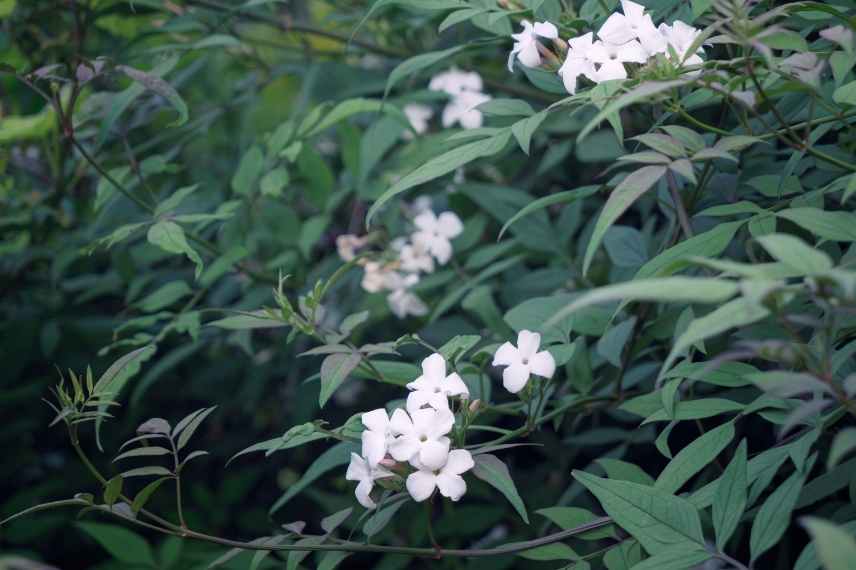 A jasmine that is easy to grow and one of the most fragrant: common jasmine or white jasmine</caption]
A jasmine that is easy to grow and one of the most fragrant: common jasmine or white jasmine</caption]
Read also
7 ideas to combine Star JasmineAccording to the colour of its flowers
Jasmines offer colours ranging from white to cream, yellow, or more or less pink.
- White jasmines: pure white from Jasminum officinale and Jasminum multipartium, to the superb cream yellow of Jasminum officinale ‘Clotted Cream’, this is the most commonly encountered colour among jasmines.
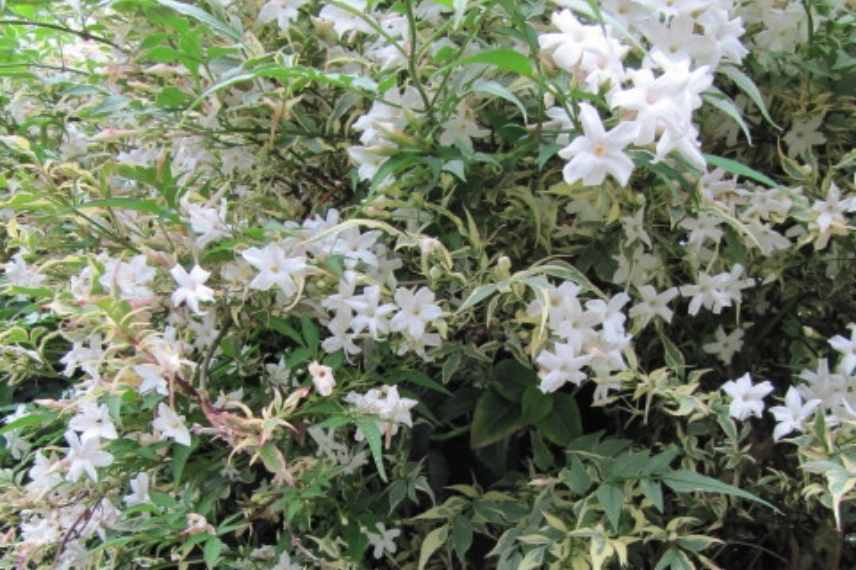
Jasminum officinale ‘Argentovariegatum’ (© L. Enking)
- Yellow jasmines: among the most well-known is the Winter Jasmine (Jasminum nudiflorum), Jasminum mesneyi or Primrose Jasmine with a very bright yellow, as well as Jasminum humile (or Italian Jasmine) and Jasminum wallichianum, and among the false jasmines, the superb Trachelospermum ‘Star of Toscane’ with a very soft pale yellow. Trachelospermum asiaticum are essentially yellow, except for a few recent horticultural varieties.
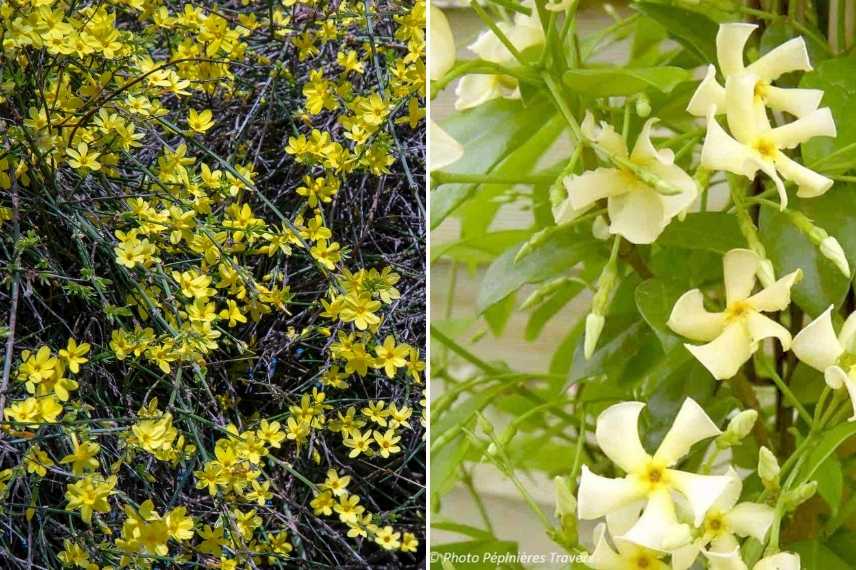
Winter Jasmine and Star Jasmine ‘Star of Toscane’
- Pink jasmines: a less common colour, but a few cultivars are involved, such as Jasminum x stephanense with magnificent pale pink flowers, Jasminum bessianum or Bee’s Nest Jasmine with a vibrant raspberry pink. Jasminum polyanthum has the particularity of delicate pink buds before it unfolds its starry white flowers in early spring. Among the star jasmines, Trachelospermum asiaticum ‘Pink Showers’ renews the genus with a slightly pink flowering.
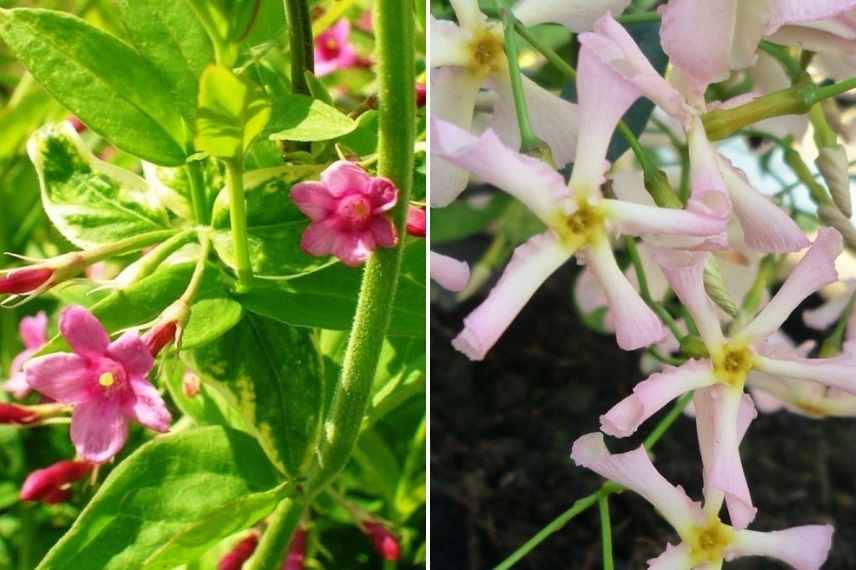
Jasminium beesianum and Trachelospermum ‘Pink Showers’
According to its foliage
Among the various species of jasmine, we distinguish the evergreen jasmines, whose leathery and glossy foliage does not fall regardless of the region: these include the star jasmines (Trachelospermum jasminoides), as well as Brazilian jasmine (Mandevilla or Dipladenia sanderi), and Azorean jasmine (Jasminum azoricum). Often changing colour due to the cold in winter, the leaves of star jasmines take on stunning shades of red to purple.
Deciduous jasmines have softer foliage, generally lighter, ranging from light green to medium green: common jasmine, Chilean jasmine, St. Stephen’s jasmine, and winter jasmine (Jasminum nudiflorum). In mild climates, this foliage will be semi-evergreen.
Some varieties are truly unique due to their foliage: golden in Jasminum officinale ‘Aureum’ and ‘Fiona Sunrise’, or the unusual Trachelospermum asiaticum ‘Theta’ with very fine, greyish leaves. Trachelospermum jasminoides ‘Variegatum’ and Trachelospermum jasminoides ‘Sun Lover’ feature beautiful cream-variegated foliage. The star jasmine ‘Winter Ruby’ stands out for its autumnal purple foliage. As for Trachelospermum asiaticum ‘Tricolor’, it surprises with its pink and white emerging foliage, evolving to variegated green and purple in autumn (though it is not very floriferous).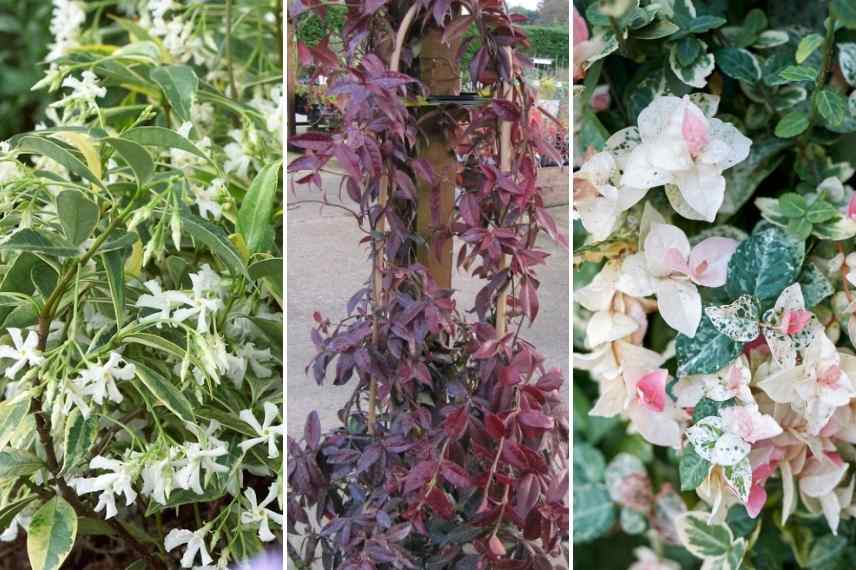 Star jasmine ‘Sun Lover’, reddening foliage of a Trachelospermum jasminoides in winter (© L. Enking), and to the right, foliage of the cultivar ‘Tricolor’
Star jasmine ‘Sun Lover’, reddening foliage of a Trachelospermum jasminoides in winter (© L. Enking), and to the right, foliage of the cultivar ‘Tricolor’
→ Learn more in our article: 5 jasmines with decorative foliage
According to its hardiness
Jasmine often carries the image of a frost-sensitive plant… this overlooks the numerous horticultural varieties that allow this magical plant to be grown almost anywhere in the country by selecting less tender varieties, which should still be protected with a thick mulch in winter and planted in a sheltered position from the winds.
Most jasmines are actually quite hardy, but three more temperamental species will be grown in pots, to be stored in a greenhouse or conservatory outside of mild climate regions: Jasminum polyanthum, or white jasmine, Jasminum grandiflorum, and Jasminum sambac. The same applies to Brazilian Jasmine (Dipladenia sanderi).
Among the hardiest jasmines, winter jasmine takes the crown, particularly resistant down to -15 °C (it also tolerates drought well once established). The star jasmines also withstand negative temperatures down to -10 °C to -15 °C. Common jasmine also stands out with fairly good hardiness: its stump can survive in the ground down to -15 °C, but its aerial parts are affected starting at -10 °C.
It is worth noting that it is the horticultural varieties that will be the most resilient, as the species type does not allow for outdoor use in our latitudes.
→ Learn more in our articles: Which jasmine to plant according to your region? and our Top 5 hardiest jasmines for your garden.
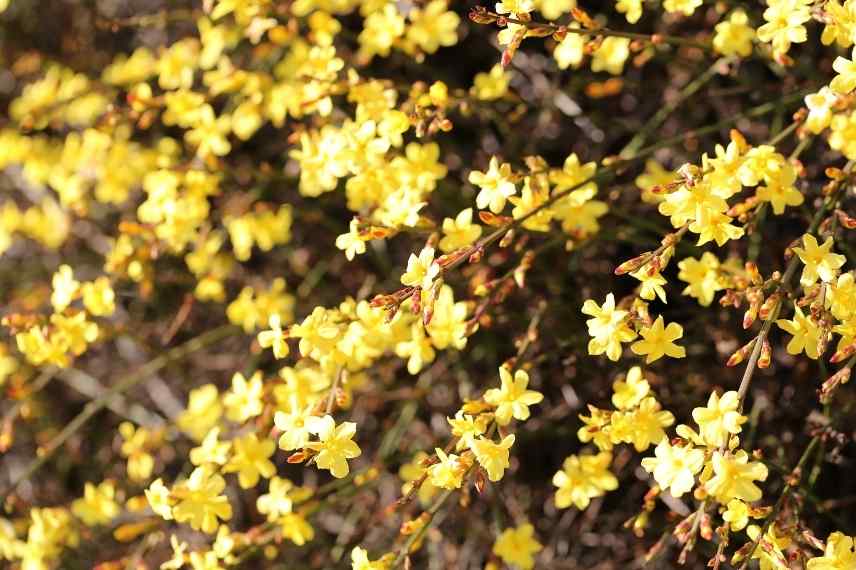 Winter jasmine, the hardiest of jasmines…
Winter jasmine, the hardiest of jasmines…
Depending on the exposure
Jasmine needs sunlight to bloom well, but some varieties can tolerate partial shade or even light shade, such as the star jasmine Trachelospermum jasminoides. In any case, always plant your jasmine sheltered from east and north winds to protect it during the harshest winter. Some jasmines, like common jasmine, are sensitive to scorching sun that can scorch their foliage.
- In full sun only: Jasminum grandiflorum, Jasminum polyanthum, Mandevilla laxa
- In partial shade: Jasminum officinale, Jasminum nudiflorum, Jasminum wallichianum, Jasminum x stephanense and Jasminum beesianum (in the South),
- In light shade: Trachelospermum jasminoides ‘Variegatum’ and its variegated foliage tolerate light shade well. Star jasmines and winter jasmines also do, but they will bloom a bit less…
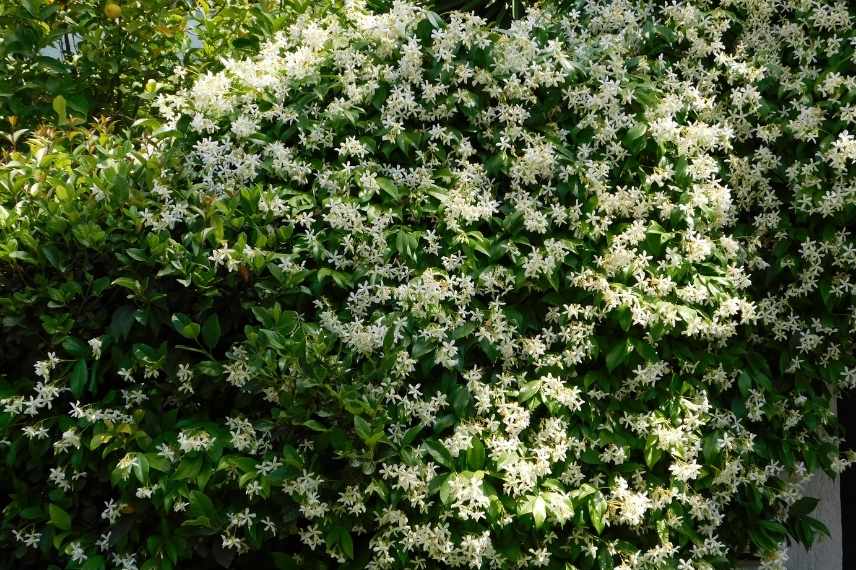 Star jasmine can thrive in partially shaded areas
Star jasmine can thrive in partially shaded areas
According to its dimensions
Jasmines develop at very different heights depending on the variety, which is an important criterion to consider based on the space you wish to cover. We will also distinguish between non-sarmentous liana jasmines and shrub jasmines.
- Small jasmines 1 m to 2 m, very useful when space is limited or in a small garden: Jasminum grandiflorum, which remains small (about 1.50 m), Trachelospermum asiaticum ‘Theta’, as well as Jasminum sambac and Jasminum multipartitum, perfect for pot cultivation.
- Medium jasmines 2 m to 3 m: Jasminum humile, Jasminum nudiflorum, several star jasmines…
- Large jasmines over 4 m: Jasminum officinale (very voluble up to 8 m!), Jasminum nudiflorum (or winter jasmine), Jasminum polyanthum, and Trachelospermum jasminoides growing up to 6 m high.
- Ground-cover jasmines (see below in “usage”)
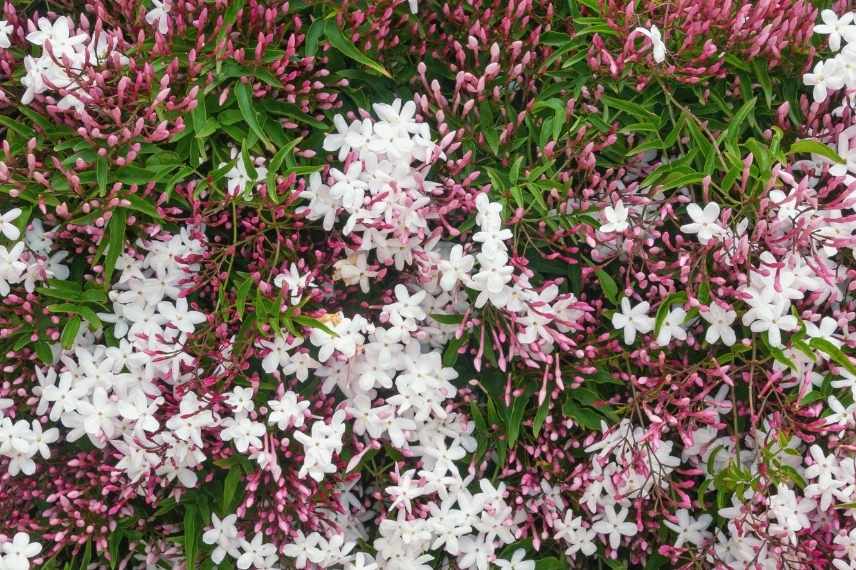
Among the many medium-sized jasmines: Jasminum polyanthum
Depending on the use
Primarily a climbing plant, jasmine can adorn walls, pergolas, fences, and other trellises. Its vigour is indeed perfect for quickly covering such supports on a terrace or in front of a house.
Some jasmines have a more woody climbing stem and grow less tall, such as Jasminum sambac. The jasmines grown in pots on the terrace should be chosen from the following varieties: Jasminum grandiflorum and Jasminum sambac, as well as some false jasmine (Trachelospermum jasminoides) of smaller size.
Some jasmines, finally, are rather creeping, making perfect ground covers, such as Jasminum parkeri, native to India, which reaches about 20 cm in height and is covered in yellow flowers in June, or the ‘Ogon-Nishiki’ star jasmine, with its astonishing multicoloured foliage and summer yellow flowering. ‘Tricolor’ star jasmine is another cultivar suitable for ground cover, especially as it flowers little, growing between 30 cm and 1 m at most in height.
It is worth noting that winter jasmine is very resistant to urban pollution, making it perfect for covering an unsightly fence in a city garden.
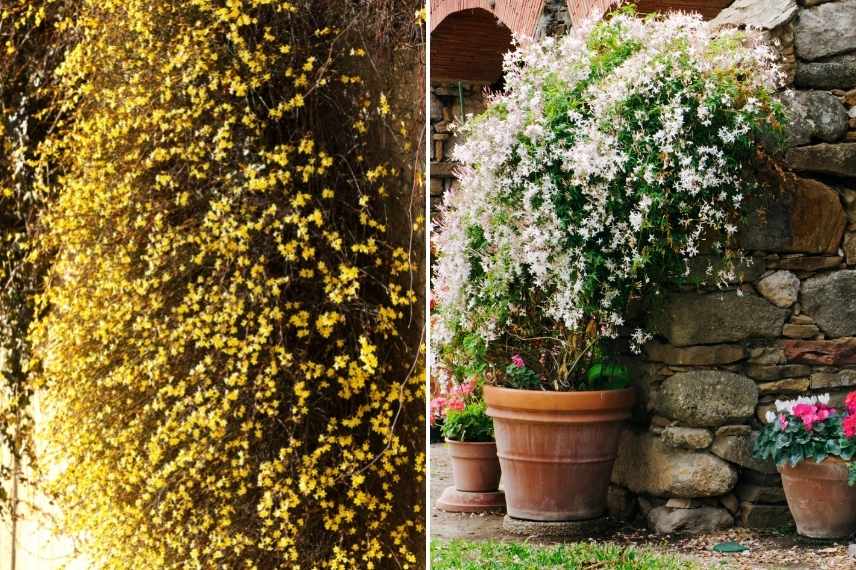
Adorning a wall, planted in a large pot, jasmine lends itself to multiple situations in the garden
According to its growth
Common Jasmine (or jasmine officinal) is the fastest growing, capable of producing shoots of 2 m in a single season. However, the champion in growth speed is Jasminum polyanthum as well as Jasminum grandiflorum. Allow the star jasmines to settle in during the first 3 years, as they may seem slow to grow, but will develop normally after this period.
- Subscribe!
- Contents
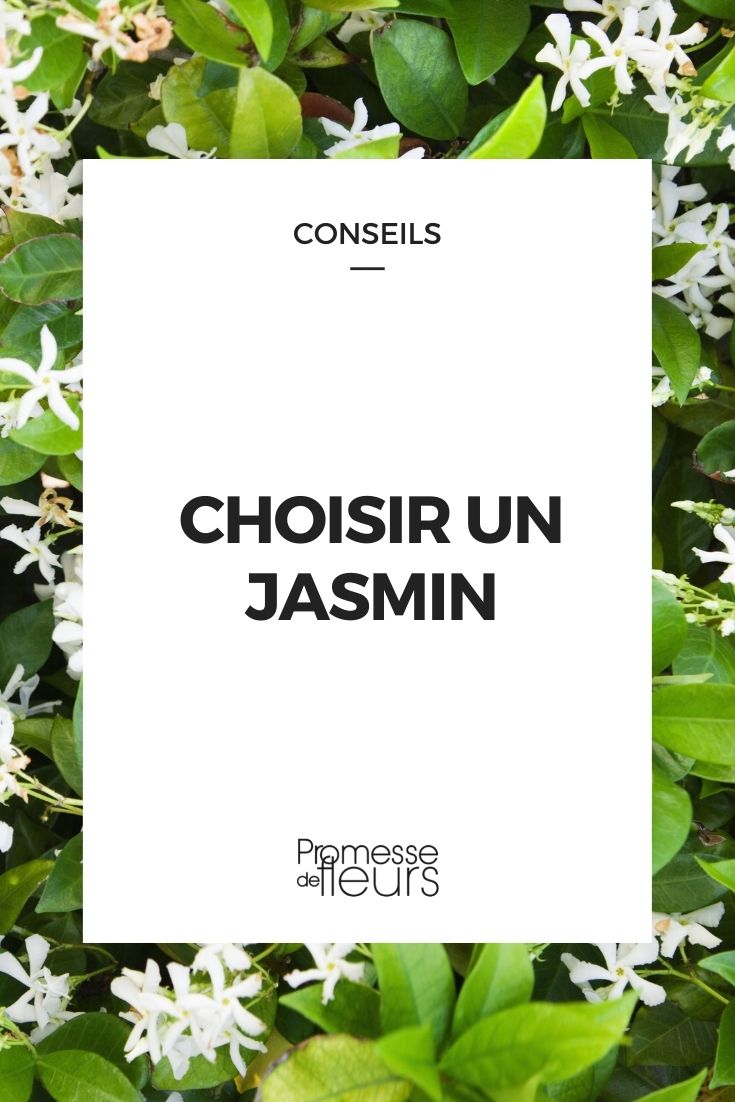































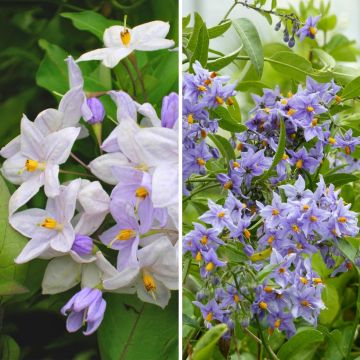
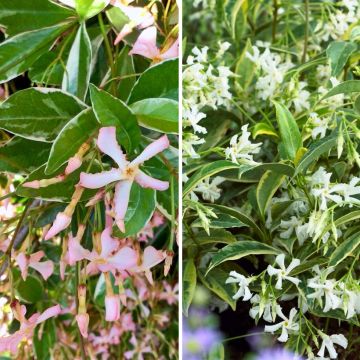
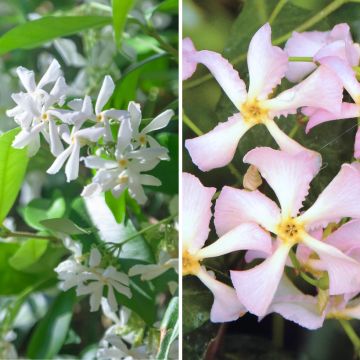

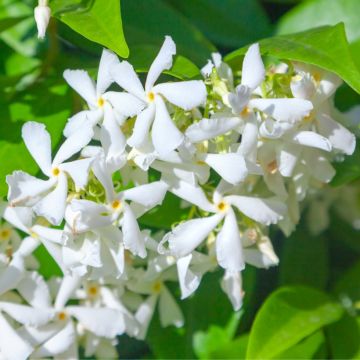
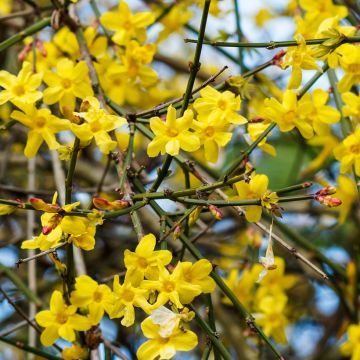
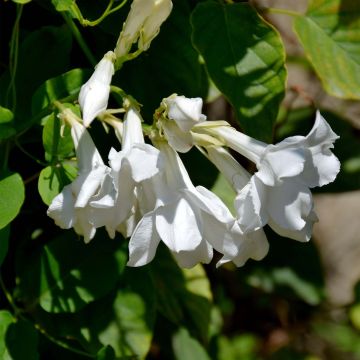
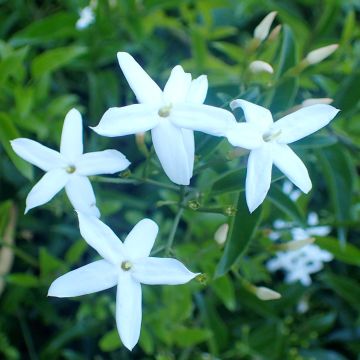
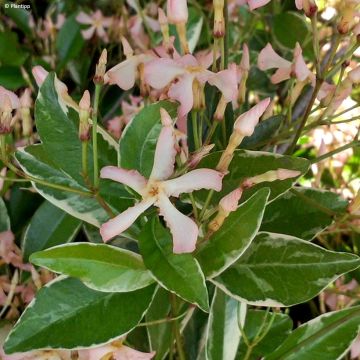
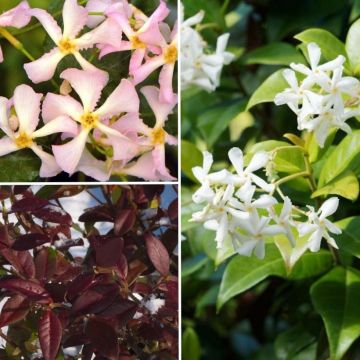
Comments